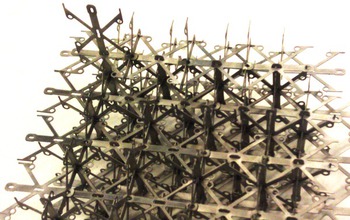Multimedia Gallery
A metallic digital material is shown here.
A metallic digital material is shown here. Digital materials are bulk composites from digital parts with programmable material characteristics. This method has produced the lightest, strongest materials in existence, as well as materials with tunable and exotic responses to external and internal loads. Fabrication efficiency of these materials scales with the development of assembler robots that use the geometry of the lattice for locomotion and error-correction.
Credit: The Center for Bits and Atoms, MIT.
Images credited to the National Science Foundation, a federal agency, are in the public domain. The images were created by employees of the United States Government as part of their official duties or prepared by contractors as "works for hire" for NSF. You may freely use NSF-credited images and, at your discretion, credit NSF with a "Courtesy: National Science Foundation" notation.
Additional information about general usage can be found in Conditions.
Also Available:
Download the high-resolution PNG version of the image. (2.6 MB)
Use your mouse to right-click (Mac users may need to Ctrl-click) the link above and choose the option that will save the file or target to your computer.
Related story: Learn the latest on advanced manufacturing at a June 17 Capitol Hill briefing



